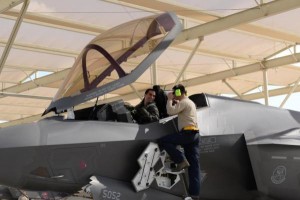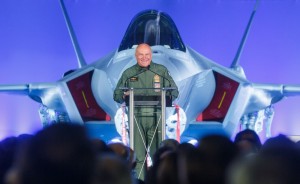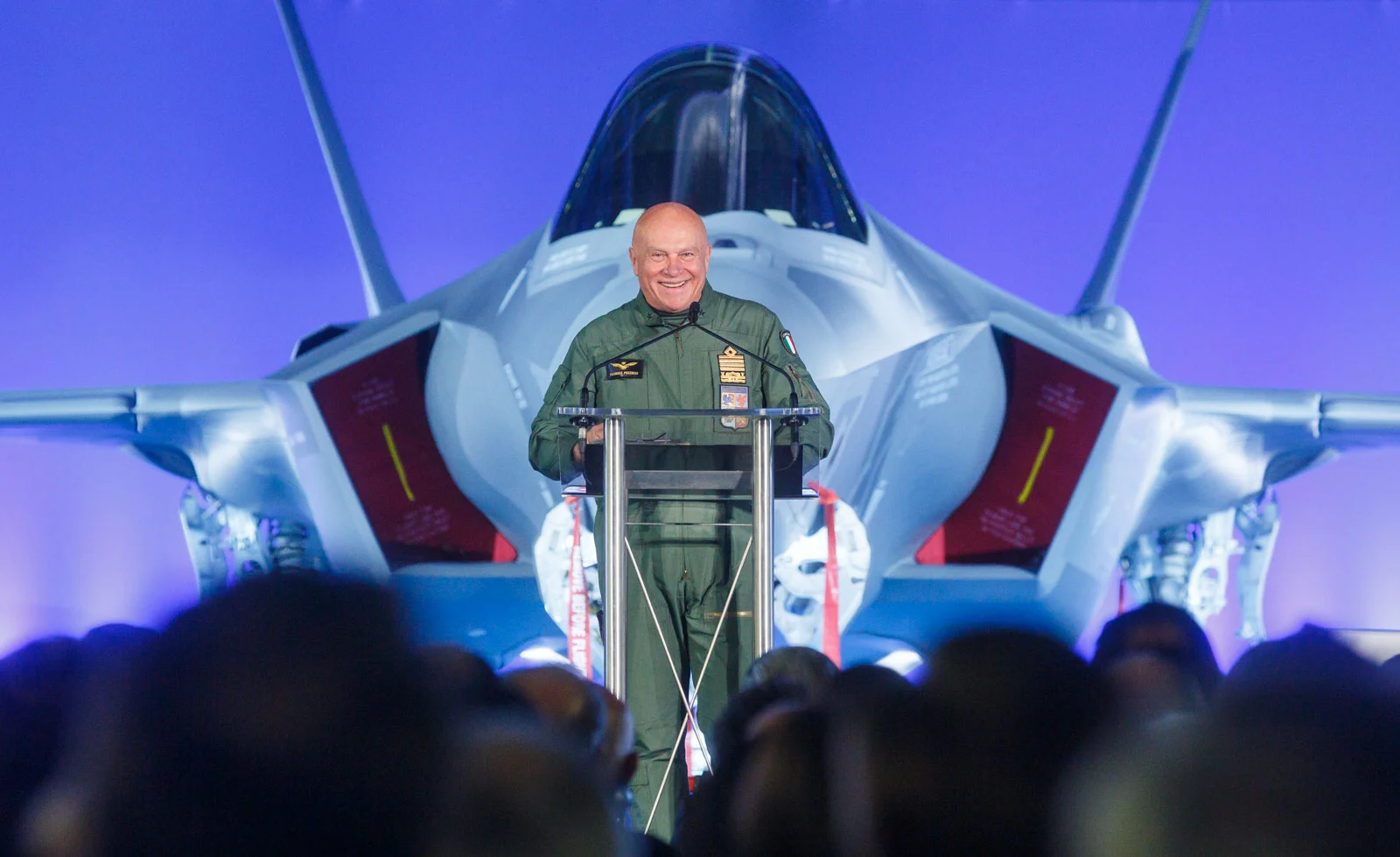2015-12-06 By Robbin Laird
At the beginning of the 20th Century, Italy was a pioneer in combat aviation.
Although different at the beginning of the 21st century, Italy has again emerged as an important player in military aviation.
They are key players in the two key 21st century multinational military aviation industrial coalitions, Eurofighter and F-35, as well as establishing a center of excellence for pilot training along with introducing one of the best 21st century trainers, the Aermacchi M-346.
In late September, in the famous Italian Air Ministry building in the center of Rome, I had a chance to conduct my third interview with Lt. General Preziosa, the Chief of Staff of the Italian Air Force.
The Italians like the British are undergoing a double transition, whereby the Eurofighter is being modernized in two ways, namely, subsuming Tornado missions and replacing the Tornado and adding a new AESA radar to the airplane and introducing the F-35 to help shape joint force transformation.
The Italians have built a significant facility at Cameri air base to build the F-35, wings for F-35s and to provide sustainment for the operational fleet throughout the region as well.
Earlier this Fall, the first F-35 came off of the Cameri line and flew successfully in Italian Air Space.
The facility was built in only four years and the first flight was ahead of schedule.
On Sept. 7, the first F-35A assembled outside the US, made its very first flight from Cameri airbase.
The aircraft, designated AL-1, is the first of eight aircraft currently being assembled at the Final Assembly and Check Out (FACO) facility at Cameri, in northwestern Italy.
During the flight, that lasted about 1,5 hours, the F-35A was escorted by a Eurofighter Typhoon.As Secretary Wynne, the man who started the talks on building the Italian facility with the Italians put it with regard to the importance of the event:
“This flight makes the F-35 truly an international program.”
Lt. General Preziosa noted “the quality of the aircraft which has come off of the Italian line clearly demonstrates the competence of our industry and the importance of our strategic partnerships with U.S. and global defense industry.
The fact that the Dutch Air Force will buy planes from the Italian line is also a recognition of the quality of the Italian effort.”
For Preziosa, the F-35 is really a different type of plane, probably not well captured by the term fifth generation aircraft.
“The F-22 and the F-35 are called fifth generation aircraft, but really the F-35 is the first airplane built for the digital age.
It was conceived in and for that age, and is built around the decision tools in the cockpit and is in fact a flying brain.
And that makes it different from other aircraft.
It is a multi-tasking aircraft, and fits well into the I-phone age.
Other aircraft – with the exception of the F-22 – are built to maximize out as multi-mission aircraft, which execute tasks sequentially and directed to do so.
The F-35 fleet thinks and hunts and can move around the mission set as pilots to operate in the battlespace leverage the data fusion system.
It is a battlespace dominance aircraft; not a classic air superiority, air defense or ground attack aircraft.
It changes the classic distinctions; confuses them and defines a whole new way to look at a combat aircraft, one built for the joint force age as well.
For the Army and the Navy will discover as the F-35 fleet becomes a reality, how significant the F-35 is for their combat efforts.”
“There is nothing static in airpower; there is always a fluid dynamic, and the F-35 provides a benchmark for now for air power excellence and for several decades moving ahead we will leverage the decision tools and multi-tasking capabilities of the F-35 as well add capabilities to our Air Forces.”
After the first flight of an F-35 built outside of the United States, came the first flight of an Italian pilot of an F-35 at Luke AFB.

On November 5, 2015, Italian pilots flew a USAF F-35A and an Australian F-35A, becoming the first Italian pilots to fly the airplane.
I had a chance to talk with the two Italian pilots in a phone interview on November 6, 2015 and to get their perspective on their first flight and their sense of the way ahead.
Question: I assume that you went through what has become the basic syllabus of training of about seven weeks with simulators and classrooms, and then flew the jet?
Answer: We have about six weeks in the simulators and classroom training on the TTPs, (Tactics, Training and Procedures) to get read to fly the airplane. We have an exam with a USAF trainer and then we are ready to fly the jet.
Question: When we spent time with the Brits and the Marines, we learned that they flew each other’s aircraft, and you did the same by flying USAF and Aussie F-35s.
Could you explain how unusual this is at this phase of your training?
Answer: What you mention is one of the key points of this program.
Starting from training to tomorrow’s operations, we are learning from the ground up.
Shaping common TTPs is crucial to shaping an integrated approach.
We are training on the same basis from the ground up.
This is the very first combat aircraft program which has this capability built into.
We have come to Sheppard to train with the USAF, but it is a trainer, and we do not share TTPs as we are doing with the F-35.
We start with the shared TTPs and then go from there.
Question: In other discussions with experienced pilots who have become F-35 pilots, all mention that the mental furniture associated with operating a multi-mission aircraft versus a multi-tasking aircraft is very different.
They also emphasized how crucial it is to get into the F-35 to move on to understand the transformation of airpower.
What is your sense of this shift?
Answer: The aircraft is so easy to fly that you spend 99 per cent of your time shaping a strategy as you use your two screens.
You are focused on your mission, instead of flying your jet and trying to achieve your mission.
We are very happy to be part of the program and to understand from the ground up how significant a shift the F-35 coalition capability is going to be.
Of course, we are also happy to be building our own jets and bringing them to Luke next year.
The first five Italian-built jets will take off from Cameri and fly to Luke next year.
Question: You flew an Australian jet yesterday.
You do not normally work with Australian pilots, but you will get to know them from the ground up as well as you train at Luke and fly each other’s jets.
What is your sense of this dynamic?
Answer: The young guys will grow up in a very advanced warfighting and multi-national environment because of this program.
They will be used to not just working together from time to time in an exercise, but will build in common tactics from the ground up and help each other innovate as well.
Question: We went to ACC recently, and one of the points made was that there are very few F-22 pilots free to work the culture of air power transformation based on their experience.
With the F-35 program, there is the opportunity to generate many more pilots and for these pilots to trigger ongoing airpower transformation.
What is your take on this opportunity?
Answer: Usually when we have exercises, we have to integrate on your own type of jet.
Here you are working from the ground up to shape an integrated approach.
It is hard for non-pilots to understand how significant this difference between shaping interoperability via exercises versus integration built in from the ground up.
Question: What does an integrated F-35 fleet bring to coalition combat, from your point of view?
Answer: We will write the TTPs together.
The commonality from the very beginning will be built into any operation which you do with your coalition partners.
And we are working from the ground up with the USAF, which is different as well from before.
We have made significant progress in the past two years, which is often not grasped by those not involved in the program.
And let me return to the point we discussed earlier about the difference between multi-mission and multi-tasking and the impact on operations.
You do not have to switch your configurations for air-to-air to air-to-ground or whatever the mission for which you have been pre-configured.
You can do what you need to do with the situational awareness built into the jet and the fleet and then fly to the mission.
Now the First F-35 built outside of the United States has been officially delivered to the Italian Air Force customer.

According to a press release by the F-35 Joint Program Office:
The first delivery of an F-35 outside the United States happened December 3 at the F-35 Final Assembly and Check Out (FACO) facility in Cameri Italy.
The first Italian F-35A Lightning II, known as AL-1, to the Italian armed forces, marked a production milestone for Italy’s national defense and aerospace industry.
“When Leonardo DaVinci first envisioned human flight as an Italian creation, there is no way he could have imagined what we have here today,” said Lt. Gen. Chris Bogdan, F-35 Joint Program Executive Officer.
“The F-35 aircraft built here in Cameri will take flight on the wings of Italian craftsmanship, ingenuity, and skill and will help build the first global fleet of fifth generation fighters.”
Italy is the sixth nation to receive an F-35 joining Australia, Netherlands, Norway, United Kingdom and the United States with jets in their service’s inventory.
The F-35s being assembled and delivered at the Italian FACO will transition to Italy’s Aeronautica Militare (Air Force) and Marina Militare (Navy). AL-1 first rolled out of the production facility in March with first flight Sept. 7, one month ahead of schedule.
Italy’s first two pilots have begun F-35 flight training at Luke Air Force Base, Arizona, where Cameri-built F-35As will be delivered in 2016 to support international pilot training.
“This is a monumental achievement for the F-35 program,” said Lorraine Martin, Lockheed Martin F-35 Program General Manager.
“The F-35 provides Italy’s aerospace industry with high technology work, ensuring the future health and competitiveness for their defense industry.
To date, Italian industry has contracts worth more than $1 billion, along with opportunities for additional work over the life of the program.”
The F-35 is a next generation fighter which combines advanced low observable stealth technology with fighter speed and agility, fully fused sensor information, network-enabled operations and advanced sustainment.
Three distinct variants of the F-35 will replace the A/OA-10 Thunderbolt II and F-16 Fighting Falcon for the U.S. Air Force, the F/A-18 Hornet for the U.S. Navy, the F/A-18 and AV-8B Harrier for the U.S. Marine Corps, and a variety of fighters for at least 10 other countries.
Following the U.S. Marine Corps’ July 30th combat-ready Initial Operational Capability (IOC) declaration, the U.S. Air Force and Navy intend to attain service IOC in 2016 and 2018, respectively. More than 150 production F-35s have been delivered to customers and have flown more than 45,000 flight hours fleet-wide.
Lt. General Preziosa highlighted during his remarks that the F-35 is an aircraft, which can elaborate and deliver operational intelligence in the battlespace.
But the challenge will be for the users to be “wise and intelligent themselves in learning how best to use the new capabilities effectively.”
Editor’s Note: The following brochure in Italian explains the F-35 program in Italy and the role of Cameri


